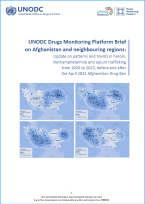
The evidence reported in this brief is based on the analysis of geo-coded individual drug seizure data housed within the UNODC Drugs Monitoring Platform. The platform consists of a dataset fed by different layers of information. It is mainly based on significant drug seizures currently communicated to UNODC by Member States via the officially mandated Individual Drug Seizure data collection channel, though some information gaps resulting from insufficient reporting by national authorities are addressed by using public data, mainly from government sources and data from other contributors, as and where relevant.
The Drugs Monitoring Platform and its analytical outputs aim at examining possible changes in trafficking patterns and providing knowledge that can support law enforcement, strategic responses and policymakers. This is based on a constantly evolving and expanding dataset, and several data caveats should be borne in mind. These data can provide insights into some overarching trends in drug trafficking. However, there are limitations to interpretation. For one, seizure events are a function of illegal flows, interdiction efforts, and counter-smuggling efforts. Changes in any one of these factors may therefore result in increases or decreases in seizures, thus affecting interpretation.
This analysis is based on selected countries situated along stages of the so-called Southern route (including East and Southern Africa), and along the Balkan, Caucasus, and Northern routes (excluding Western and Central Europe), focusing on seizures of heroin, methamphetamine, and in some cases opium, taking place in South-West Asia, South Asia, the Near and Middle East, Eastern Europe, South-Eastern Europe, Central Asia and Transcaucasia. Seizures in bodies of water within the mentioned subregions, such as the Gulf of Oman, the Arabian Sea or the Indian Ocean, are also included and referred to as “maritime” seizures.


